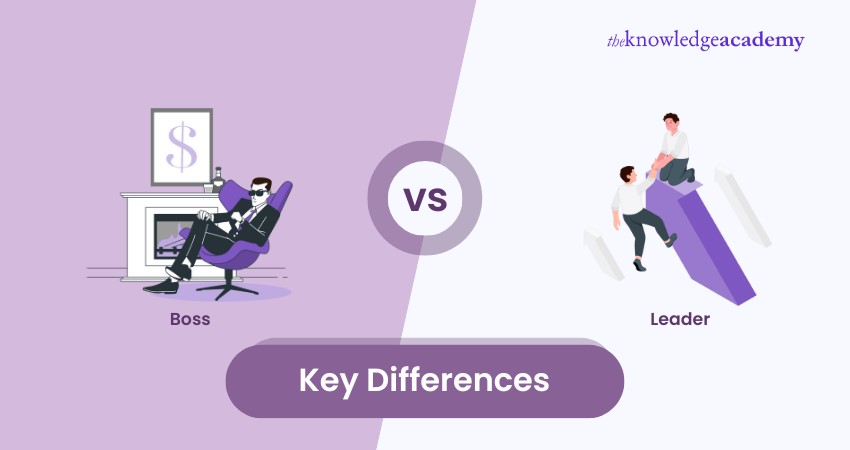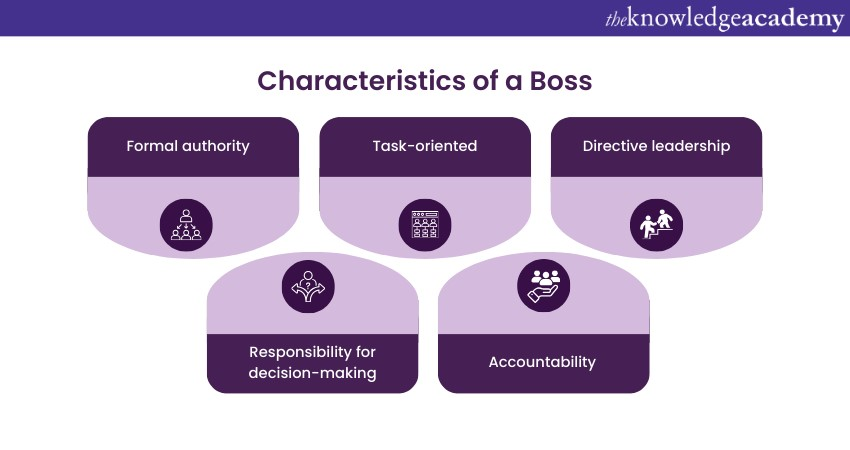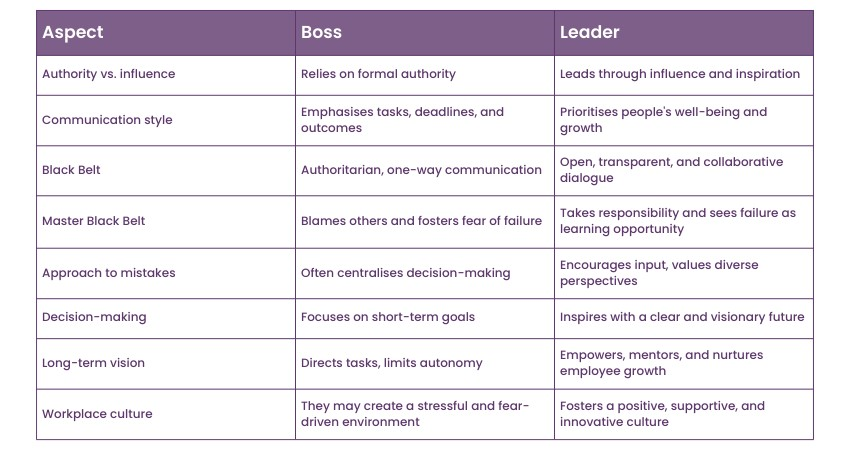We may not have the course you’re looking for. If you enquire or give us a call on +971 8000311193 and speak to our training experts, we may still be able to help with your training requirements.
Training Outcomes Within Your Budget!
We ensure quality, budget-alignment, and timely delivery by our expert instructors.

In any corporate setting, the Boss and Leader stand as two distinct roles. However, organisations use these terms interchangeably. But you don’t make the same mistake, understand the differences between Boss vs Leader so that you can choose a workplace where you can thrive and build your technical as well as interpersonal skills.
If you want to have good professional growth, you need to know the kind of leadership you are training under. So, what are you waiting for? Read this blog to learn about the critical differences between Boss vs Leader, their roles and responsibilities so that you can choose a thriving workplace.
Table of Contents
1) Who is Boss?
2) Understanding who is a Leader
3) Differences between a Boss and a Leader
a) Authority vs. influence
b) Focus on tasks vs. focus on people
c) Blame vs. accountability
d) Communication styles
e) Long-term vision vs. short-term goals
f) Impact on workplace culture and employee satisfaction
4) Conclusion
Who is a Boss?

The term Boss refers to an individual within an organisation who holds a position of authority, often by virtue of their title or hierarchical position. A Boss is someone responsible for delegating tasks, making decisions, and overseeing the work of employees. These individuals tend to rely on their formal authority and the power vested in their position to enforce rules, allocate resources, and manage the workflow.
Their approach is often directive, emphasising immediate goals and ensuring tasks are completed within specified deadlines. While Bosses play a crucial role in maintaining order and structure within an organisation, their style of management can sometimes be authoritarian. This means that they focus more on the tasks at hand than on the individuals performing them.
Who is a Leader?
A Leader is an individual who inspires, guides, and empowers others to reach their full potential. Unlike a Boss, a Leader's influence goes far beyond their formal position. These individuals are visionaries, possessing a deep understanding of their team's strengths and weaknesses. They create an environment of respect and trust, open communication and collaboration.
A true Leader is empathetic, recognising the unique needs and aspirations of each team member, and is dedicated to nurturing their growth. They lead by example, demonstrating integrity, resilience, and a relentless pursuit of excellence. Moreover, they encourage innovation, embracing diverse perspectives and fostering a culture of continuous learning.
They are also adept at resolving conflicts, promoting teamwork, and celebrating achievements, creating a positive and inclusive workplace where everyone feels valued. Ultimately, a Leader's legacy is measured not by the tasks accomplished but by the lives they positively impact and inspire.
Want to learn how to master People Management? Then sign up now for our Successful People Management and Team Leadership Course.
Differences between a Boss and a Leader
After learning about the key characteristics of each role, let’s discuss the differences between a Boss vs Leader. They are as follows:

Authority vs. Influence
Bosses often rely on their formal title and the authority vested in their position to exert control. Their commands are rooted in the hierarchical structure of the organisation, where obedience is expected. In contrast, a Leader's influence stems from a profound understanding of their team, gained through empathy and genuine connection. They inspire loyalty not because of their title but because they lead with purpose and conviction. Leaders influence others through mentorship, encouragement, and by setting an example of integrity and dedication.
While a Boss demands compliance, a Leader inspires commitment. A Boss may instil fear to get the job done, but a Leader garners respect and trust. Thus, they create a harmonious environment where team members willingly contribute their best.
Focus on tasks vs. focus on people
A Boss predominantly emphasises tasks, deadlines, and outcomes. They are result-driven, often prioritising the completion of assignments over the well-being of their team members. In such environments, employees might feel like mere cogs in a machine, valued for their productivity rather than their individuality.
On the other hand, a Leader focuses on people. They recognise that a motivated and satisfied workforce is essential for achieving organisational goals. They invest time and effort in understanding the strengths, weaknesses, aspirations, and concerns of their team members. By valuing their employees as individuals, they create a supportive atmosphere where people feel appreciated and understood.
Elevate your leadership skills to new heights with our Leadership Skills Course - join today!
Blame vs. accountability
A Boss, when faced with setbacks, tends to resort to blame as a way of deflecting responsibility. This blame game creates a culture of fear, stifling creativity and innovation. Employees become hesitant to take risks, fearing reprisal for any potential failure. Consequently, this environment hampers the growth of both individuals and the organisation.
In contrast, a Leader fosters a culture of accountability. They understand that mistakes are part of the learning process. When something goes wrong, they step forward, take responsibility, and view the situation as an opportunity for learning and growth. In such an environment, team members feel safe to experiment, knowing they won’t face harsh consequences for honest mistakes. This approach not only encourages innovation but also builds resilience and a sense of ownership among employees.
Communication styles
A Boss often adopts an authoritative communication approach, where instructions are given with little room for dialogue. This one-way communication can create a sense of detachment between management and employees. The lack of open channels for feedback hampers creativity and discourages employees from expressing their ideas or concerns. This communication style is efficient for task delegation but does little to foster a collaborative and innovative environment.
Conversely, a Leader engages in open, transparent, and two-way communication. They actively listen to their team members, valuing their input and perspectives. They encourage discussions, welcome feedback, and create an atmosphere where everyone feels heard. By nurturing an environment where ideas can be freely exchanged, they stimulate creativity and problem-solving.
Moreover, they are also skilled at delivering feedback constructively, inspiring growth rather than fear. This form of communication builds trust, strengthens relationships, and promotes a sense of belonging among team members.
Long-term vision vs. short-term goals
A Boss tends to focus primarily on immediate, short-term objectives. Their attention is often directed towards achieving quick results, meeting deadlines, and fulfilling quotas. While this approach might yield temporary successes, it rarely leads to sustainable growth or innovation. It can create a myopic organisational culture where decisions are made based on immediate gains without considering the long-term consequences.
In contrast, a Leader operates with a visionary perspective, looking beyond the horizon of immediate goals. Leaders have a clear, inspiring vision for the future of the organisation. They possess the ability to articulate this vision, motivating their team members to work towards shared, long-term objectives. They also emphasise the importance of strategic planning and sustainable growth. They encourage creativity and innovation, fostering an environment where employees are empowered to think beyond short-term gains.
Impact on workplace culture and employee satisfaction
A Boss may make employees feel stressed, undervalued, and hesitant to voice their opinions. This stifling atmosphere leads to high turnover rates, diminished morale, and a lack of enthusiasm for work. Such a culture does not foster loyalty or a sense of belonging, making it challenging for employees to find fulfilment in their roles.
On the other hand, a Leader is compassionate and empowering, transforming the workplace into a vibrant ecosystem of collaboration and mutual respect. Employees feel valued, appreciated, and encouraged to contribute their ideas. Their ability to inspire, mentor, and provide constructive feedback fosters an environment of trust.
In this atmosphere, employees are motivated to excel, feeling secure enough to take risks and explore innovative solutions. Job satisfaction soars as individuals find purpose in their work and recognise their impact on the organisation.
Want to learn how various Leadership styles help organisations? Register now for our Leadership Training.
Conclusion
We hope that you have learnt the significant differences between a Boss vs Leader. It would be best if you remember that your professional as well as personal growth can happen only in a workplace, which will allow you to express yourself and give you room to grow. After knowing the differences between them, we hope that you can choose a workplace which will suit your needs.
Learn the best Leadership and Management skills with our Leadership and Management Skills Course - join now!
Frequently Asked Questions
Upcoming Business Skills Resources Batches & Dates
Date
 Introduction to Business Analytics Training
Introduction to Business Analytics Training
Fri 21st Feb 2025
Fri 25th Apr 2025
Fri 20th Jun 2025
Fri 22nd Aug 2025
Fri 17th Oct 2025
Fri 19th Dec 2025







 Top Rated Course
Top Rated Course



 If you wish to make any changes to your course, please
If you wish to make any changes to your course, please


